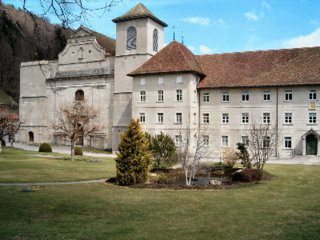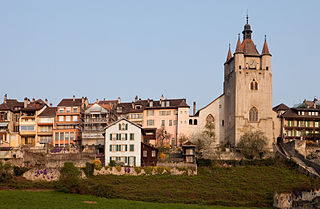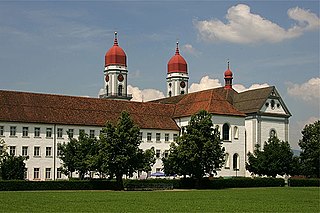 W
WBellelay Abbey is a former Premonstratensian monastery in the Bernese Jura in Switzerland, now a psychiatric clinic. It is a heritage site of national significance and the entire former Abbey complex is part of the Inventory of Swiss Heritage Sites.
 W
WBern is the de facto capital of Switzerland, referred to by the Swiss as their "federal city", in German: Bundesstadt, French: ville fédérale, and Italian: città federale. With a population of about 144,000, Bern is the fifth-most populous city in Switzerland. The Bern agglomeration, which includes 36 municipalities, had a population of 406,900 in 2014. The metropolitan area had a population of 660,000 in 2000.
 W
WBonmont Abbey is a former Cistercian monastery in the municipality of Chéserex in the canton of Vaud in Switzerland. It is a Swiss heritage site of national significance.
 W
WEngelberg Abbey is a Benedictine monastery in Engelberg, Canton of Obwalden, Switzerland. It was formerly in the Diocese of Constance, but is now in the Diocese of Chur. It is dedicated to Our Lady of the Angels and occupies a commanding position at the head of the Nidwalden Valley.
 W
WFahr Convent, is a Benedictine convent located in the Swiss municipality of Würenlos in the canton of Aargau. Located in different cantons, Einsiedeln Abbey and Fahr Convent form a double monastery, overseen by the male Abbot of Einsiedeln, no converse arrangement appears to be available for the Abbess of Fahr. Fahr and Einsiedeln may be one of the last of such arrangements to survive.
 W
WThe Fraumünster is a church in Zürich which was built on the remains of a former abbey for aristocratic women which was founded in 853 by Louis the German for his daughter Hildegard. He endowed the Benedictine convent with the lands of Zürich, Uri, and the Albis forest, and granted the convent immunity, placing it under his direct authority. Today, it belongs to the Evangelical Reformed Church of the canton of Zürich and is one of the four main churches of Zürich, the others being the Grossmünster, Prediger and St. Peter's churches.
 W
WHohensax is a ruined castle in the Sennwald municipality in the Swiss canton St. Gallen. The castle was built around 1200 by the barons of Sax, and was destroyed in 1446. In 1248, the castle passed to Ulrich von Sax, founder of the Sax-Hohensax line of the noble family. The castle was plundered in a feud of 1393, and sold together with the villages of Sax and Gams to the dukes of Austria. In the Old Zürich War, the people of Appenzell captured and slighted the castle in 1446. After this, the barons of Hohensax resided in the nearby Forstegg castle at Salez. In 1640, the ruin passed to the barony of Sax-Forstegg, one of the constituent parts of the canton of Linth of the Helvetic Republic in 1798, and later the canton of St. Gallen. It included the villages of Sax, Salez and Gams.
 W
WKreuzlingen Abbey, in Kreuzlingen in Switzerland, on the border with Germany, was founded in about 1125 by Ulrich I of Dillingen, Bishop of Constance, as a house of Augustinian Canons. In 1848 the government of the Canton of Thurgau dissolved the monastery and took over its property. The former abbey church of Saint Ulrich and Saint Afra, decorated in the Baroque style, is noteworthy.
 W
WOrbe Temple, also known as the Reformed Church of Notre-Dame or the Great Church of Orbe, is a Protestant church in the municipality of Orbe, canton of Vaud, Switzerland. It is a parish church of the Evangelical Reformed Church of the Canton of Vaud. It is listed as a heritage site of national significance.
 W
WSt. Urban's Abbey is a former Cistercian monastery in the municipality of Pfaffnau in the canton of Lucerne in Switzerland. It is a Swiss heritage site of national significance.
 W
WThe Swiss Reformed Church of Saint-Maurice, also named Church of Saint Marcel or simply the Chavornay Temple, is a Protestant church in the municipality of Chavornay, Vaud, Switzerland. It is a parish church of the Evangelical Reformed Church of the Canton of Vaud. It was listed as a heritage site of national significance.